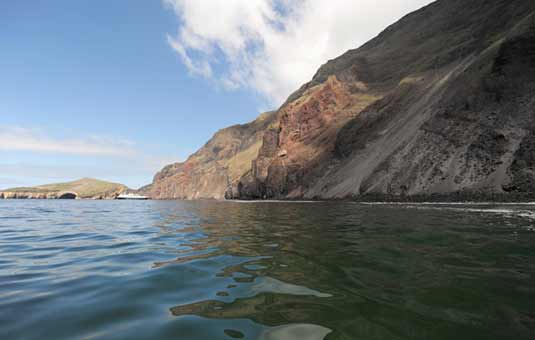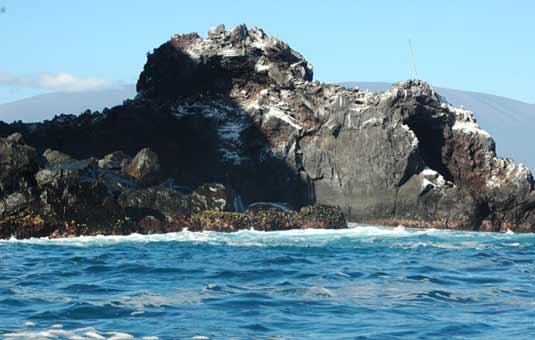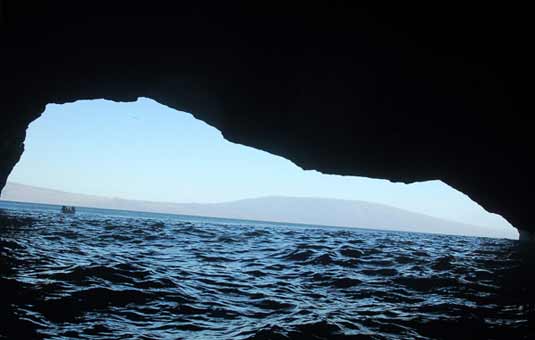Isabela Island, Galapagos
The archipelago's largest island, Isabela, was formed by the joining of five young volcanoes. While these volcanic regions contain extensive lava fields and little vegetation, the southern highlands and various other regions are covered by dense vegetation including the unique red mangrove. Isabela Island is also home to many native Galapageños living in the Island's largest town, Puerto Villamil.
Isabela Fast Facts
- The Island's five volcanoes still produce volcanic activity.
- Animals: Giant tortoise, large marine iguanas, flightless cormorants, penguins
- Area: 1771 sq. miles
- Highest Point: 5599 feet
» Isabela Hotels
Isabela Visitor sites:
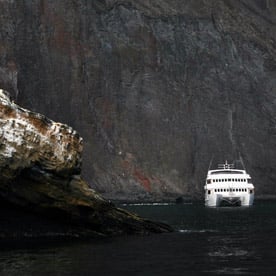
Albemarle Point
At Isabela's remote northern tip the remains of a US World War II radar base line the shore. The Point is the nesting site for flightless cormorants and home to a colony of the largest marine iguanas in the Islands. One of the most pristine visitor sites within the Galapagos National Park, here you can see a pahoehoe lava flow.
- Highlights: The largest marine iguanas
- Possible Activities: Dinghy ride
- Type of Landing: No Landing
- Difficulty: Easy
*Activities will be operated according to each boat itinerary.

Chico Volcano
Volcán Chico is a collection of smaller cones in the northeast flank of Sierra Negra. The last eruption was in November 1979. Therefore, visitors can walk on relatively recent lava flows. With an altitude of 860m.a.s.l., the site provides amazing views of the volcanoes of Isabela as well as Fernandina.
- Highlights: View from the summit
- Possible Activities: Walking
- Type of Landing: Moderate
- Difficulty: Dry
*Activities will be operated according to each boat itinerary.
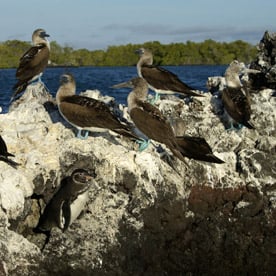
Elizabeth Bay
Elizabeth Bay is located on the east coast of Isabela Island. The bay contains many islets, which can be visited by dinghy or panga rides. Penguins and Blue-footed Boobies can be spotted on the rocky islets. With an abundance of marine life and clear water, the area is perfect for snorkeling and viewing schools of colorful fish, sea lions, and perhaps sharks or whales.
- Highlights: Mangrove forest (unique in Galapagos), sea turtles, penguins, rays, herons, sea lions.
- Possible Activities: Two-hour dinghy ride
- Type of Landing: No Landing
- Difficulty: Easy
*Activities will be operated according to each boat itinerary.
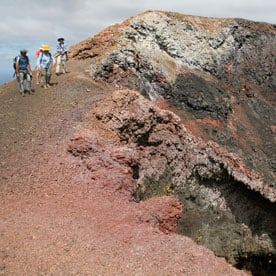
Sierra Negra Volcano
The Sierra Negra Volcano boasts the largest basaltic caldera in Galapagos at 9 x 10 km. The site offers impressive views and the opportunity to observe up to 7 species of finch and a rich display of vegetation. The north side of the caldera provides evidence of its most recent volcanic activity in 2005.
- Highlights: Basaltic caldera, stunning views, finches
- Possible Activities: Hiking, walking
- Type of Landing: Dry landing
- Difficulty: Moderate
*Activities will be operated according to each boat itinerary.
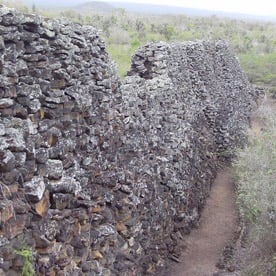
The Wall of Tears
From 1945-1959, a penal colony hosted prisoners who were forced to build this wall, stone by stone, in isolation. This now historical site (El Muro de las Lágrimas), towering at 65 feet (25m) high, took the lives of thousands during its construction. Locals claim to hear cries emanating from the heavy energy surrounding the site.
- Highlights: Historic site
- Possible Activities: Hiking
- Type of Landing: Dry landing
- Difficulty: Easy
*Activities will be operated according to each boat itinerary.
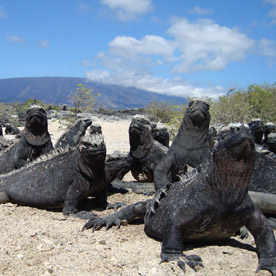
Urbina Bay
Urbina Bay is located at the base of Alcedo Volcano on the west coast of Isabela Island, between Tagus Cove and Elizabeth Bay. This area experienced a major uplift in 1954, causing the land to rise over 16 feet. The coast expanded half a mile out, leaving marine life stranded on the new shore. This area is also a great place for snorkeling.
- Highlights: Land iguanas (the biggest in Galapagos), hawks, coral reef, giant tortoises; snorkeling: turtles, rays, tropical fish
- Possible Activities: Snorkeling, dinghy ride & hike, 2 trails: short (0.6mi/1 km), long (1.9mi/3km)
- Type of Landing: Easy landing
- Difficulty: Easy /moderate
*Activities will be operated according to each boat itinerary.

Cowley Islet 
Cowley Island is a small islet surrounding Isabela Island. It is a popular dive site where one is sure to find stunning marine life.
- Highlights: Sea turtles, sea lions, reef fish
- Possible Activities: Snorkeling, diving
- Type of Landing: Easy landing
- Difficulty: Easy /moderate
*Activities will be operated according to each boat itinerary.
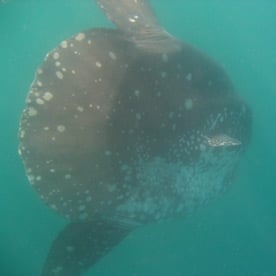
Tortuga Islet 
A deep drift wall dive filled with Galapagos specialties: Galapagos groupers, Galapagos sheephead, Galapagos sharks and more. This site leads you along the outside rim of an extinct volcano.
- Highlights: Sunfish and orcas have been spotted in this area. Stingrays, mantas, white-tipped sharks and hammerheads
- Experience: Minimum 40 dives
- Depth: 6-40 m (20-131ft)
- Currents: moderate to strong, with surge at the surface
- Average Water Temp: 20-26 C (68-78F), depending on the season
- Difficulty: Intermediate
- Visibility: 12-24 m (40-80 ft)
*Activities will be operated according to each boat itinerary.
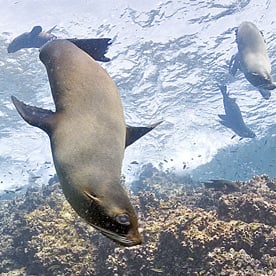
Cape Marshall 
A near-vertical wall of volcanic rock that plummets to the bottom of the sea, this dive site boasts the big stuff: manta rays, hammerheads, sun fish (Mola mola), and sometimes huge schools of the endemic salema.
The red-lipped batfish can be found here, although no night diving is permitted in Galapagos, so it will be tricky to find them!
- Highlights: Not only is the topography of this site distinct and fascinating, but so is the marine life! The "usual" sea turtles and sea lions swim along with you and the Chevron barracuda, yellow fin tuna, marbled rays, mobula rays, snappers, and more!
- Experience: Minimum advanced open water and 30 dives. Experience with current, walls, and good buoyancy needed.
- Depth: 10-35 m (33-98 feet)
- Currents: Strong
- Average Water Temp: 17C-23C / 63F-73F, depending on the season and special conditions
- Thermoclines: Prevalent at approximately 14 m (45 ft)
- Difficulty: Advanced
- Visibility: 3 – 10 m (10-33 feet)
*Activities will be operated according to each boat itinerary.
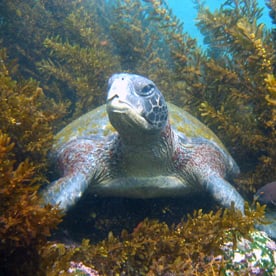
Cuatro Hermanos Islets 
A cave dive filled with surprises: from mantas to nudibranchs!
- Highlights: Galapagos sea turtles accompany the diver past white-tips, sea horses, wrasse, tiger snake eels, sea horses and more!
- Experience: Minimum 50 dives
- Depth: 7-40 m (23-131 ft)
- Currents: Strong
- Average Water Temp: 20-26 C (68-78F), depending on the season
- Difficulty: Advanced
- Visibility: 12-24 m (40-80 ft)
*Activities will be operated according to each boat itinerary.

Arnaldo Tupiza Breeding Center
The Tortoise Breeding Center (also known as the Interpretation Center) is located nearby Puerto Villamil. A boardwalk connects the town to the Center, stretching across the wetlands and Prickly Pear Cacti shrub. Five sub-species of the Giant Tortoise exist on the island, yet their populations are threatened by introduced animals such as goats and cats. At the Tortoise Breeding Center, eggs are nursed in a hatchery and the giant tortoise adults are observed in supervised corrals. The Center aims to increase the population and secure the survival of these species.
- Highlights: Two of the five sub-species of the giant tortoise.
- Possible Activities: Walking
- Type of Landing: Dry Landing
- Difficulty: Easy
*Activities will be operated according to each boat itinerary.
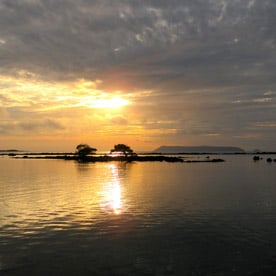
Concha de Perla
Located in the Port of Villamil, the Concha de Perla can be reached via a wooden pathway. The bay's calm, shallow, clear waters are ideal for observing the incredible array of marine life. Visitors can swim and snorkel alongside tropical fish, sea lions, penguins and turtles and it is also possible to observe up to 20 bird species.
- Highlights: Sea lions, penguins, turtles, frigatebirds, flamingos
- Possible Activities: Snorkeling, swimming, bird watching
- Type of Landing: Dry Landing
- Difficulty: Easy
*Activities will be operated according to each boat itinerary.
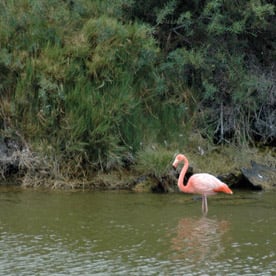
Flamingos Lake
To the west of Puerto Villamil there are various salt and brackish lagoons which house an impressive variety of coastal and sea birds. Here, visitors can also find the largest concentration of flamingos in Galapagos.
- Highlights: Flamingos, lagoons, coastal and sea birds
- Possible Activities: Bird watching, walking
- Type of Landing: Dry landing
- Difficulty: Easy
*Activities will be operated according to each boat itinerary.

Moreno Point
Moreno Point (Punta Moreno) is located near Elizabeth Bay on the west coast of Isabela Island. This is a nice area for a panga ride along the striking rocky shores and a great place to view Galapagos Penguins and shore birds. On land, a path through lava rock leads to tide pools and mangroves. These tide pools often contain green sea turtles or white-tip shark. A birdwatcher's delight, this site attracts Blue Herons, Pink Flamingoes, and Brown Pelicans.
- Highlights: Flamingoes, gallinules, pintail ducks, turtles, whitetip reef sharks.
- Possible Activities: Snorkeling, dinghy ride & hike (1.2mi/2km)
- Type of Landing: Dry landing
- Difficulty: Moderate/difficult
*Activities will be operated according to each boat itinerary.
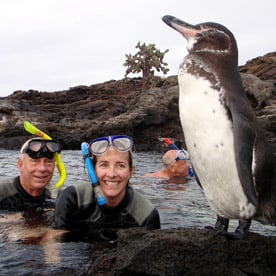
Tagus Cove
Tagus Cove is located on Isabela Island across from Fernandina Island, next to the Bolivar Channel that divides the two islands. This spot has been frequented by ships since the 1800s that used the area as anchorage. Trails lead from the cove past Lake Darwin up to a ridge displaying wonderful views. Another area of interest is Punta Tortuga. Located north of Tagus Cove, also across from Fernandina Island, this beach is surrounded by mangroves.
- Highlights: Penguins, flightless cormorants, Darwin Volcano & Lake
- Possible Activities: Long hike, snorkeling, dinghy ride
- Type of Landing: Dry landing
- Difficulty: Moderate/ difficult
*Activities will be operated according to each boat itinerary.
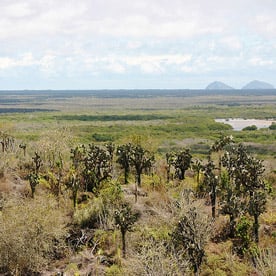
The Wetlands
The Wetlands of Isabela Island are located just outside of Puerto Villamil. The Wetlands consist of lagoons, swamps, and mangroves and are home to a variety of unique bird species such as common stilts, whimbrels, white-cheeked pintails, and gallinules. The Wetlands can be visited on foot via a path that winds through the swamps.
- Highlights: Giant mangroves, shore birds
- Possible Activities: Hike
- Type of Landing: Dry landing
- Difficulty: Easy
*Activities will be operated according to each boat itinerary.
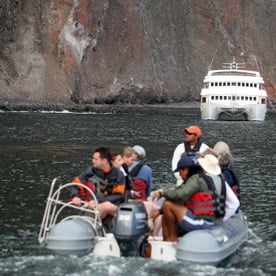
Vicente Roca Point
Located on the northwestern coast of the island and comprised of two separate coves, this site is a large bay with spectacular sea life. Seahorses, sea turtles, and the strange yet fascinating mola-mola (sunfish) may be spotted here. This bay is great for diving and snorkeling.
- Highlights: Penguins, blue-footed boobies, terns, Nazca boobies, sea lions.; snorkeling: sea turtles, rays and puffer fish.
- Possible Activities: Snorkeling & dinghy ride
- Type of Landing: No landing
- Difficulty: Easy/moderate
*Activities will be operated according to each boat itinerary.
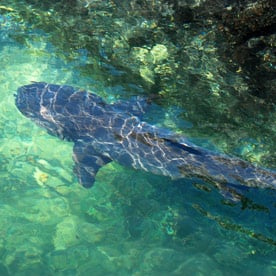
Las Tintoreras
The Tintoreras Islets, located a short distance from Puerto Villamil, is home to a great variety of wildlife. Its turquoise, crystalline waters are inhabited by white-tipped reef sharks, Galapagos penguins, marine turtles and sea lions. One of its beaches, surrounded by mangroves is one of the few sites where marine iguanas can reproduce successfully.
- Highlights: White-tipped reef sharks, penguins, marine turtles, sea lions, marine iguanas
- Possible Activities: Dinghy ride
- Type of Landing: None
- Difficulty: Easy
*Activities will be operated according to each boat itinerary.

Puerto Villamil
The most populated area of Isabela Island, Puerto Villamil is located on the southern coast of the island. The 2,200 locals depend on tourism and fishing and welcome visitors. Visitors and locals alike enjoy the relaxing beach paradise: extensive white-sand beaches, the turquoise-blue water, the sandy streets lined with palm trees provide a serene atmosphere.
Along the beach one can see iguanas, seabirds, and crabs, and on boat tours sea lions, Galapagos Penguins, and Blue-footed Boobies can be spotted. Snorkeling offers the opportunity to view manta rays, penguins, marine turtles, and colorful fish. Just north of the town, the Villamil Lagoons contain shallow wetlands, mangroves, and are a great site for bird-watching. Here one can see flamingoes and a variety of migrant waders.
- Highlights: Beautiful white sandy beach, marine iguanas, giant mangroves, small land tortoises, shore birds, blue-footed boobies, tintoreras, giant tortoise
- Possible Activities: Snorkeling, hiking
- Type of Landing: Dry landing
- Difficulty: Easy
*Activities will be operated according to each boat itinerary.
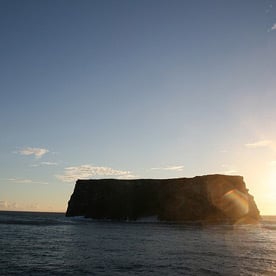
Roca Redonda 
An underwater volcano where divers can find Galapagos sharks, schools of hammerheads and barracudas. This dive site can be a challenge due to its unpredictable currents and surges. The bubbling fumaroles enhance the active volcano experience!
- Highlights: Visible fumaroles, white-tips, mantas, sun fish (or "mola mola")
- Experience: Minimum 50 dives, experience in strong currents including down currents and surges
- Depth: 10-35 m (33-98 feet)
- Currents: Strong and variable from all directions, including a downward current
- Average Water Temp: 120-26 C (68-78F), depending on the season
- Thermoclines: Generally below 14 m (45 ft)
- Difficulty: Advanced
- Visibility: 8-17 m (26-56)
*Activities will be operated according to each boat itinerary.
